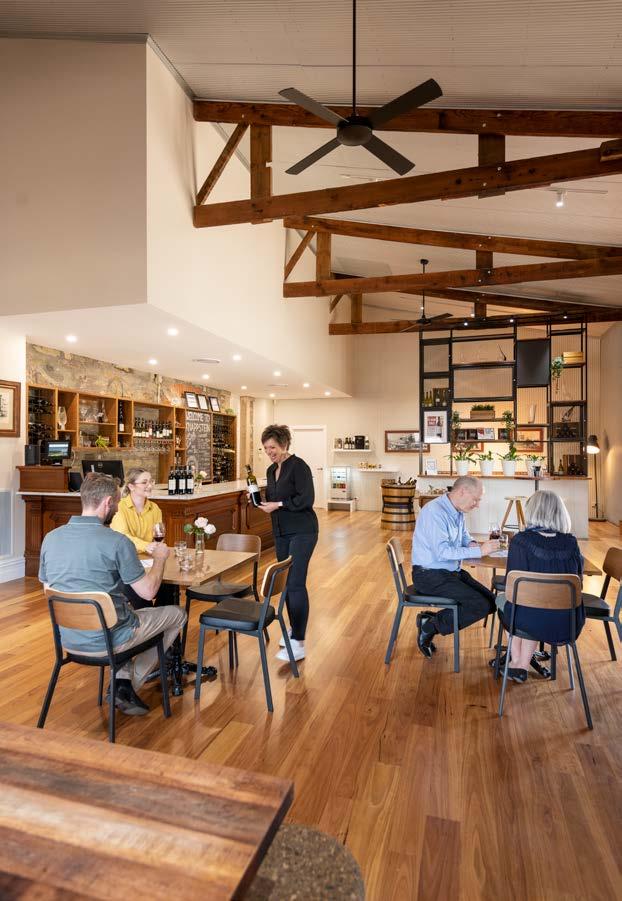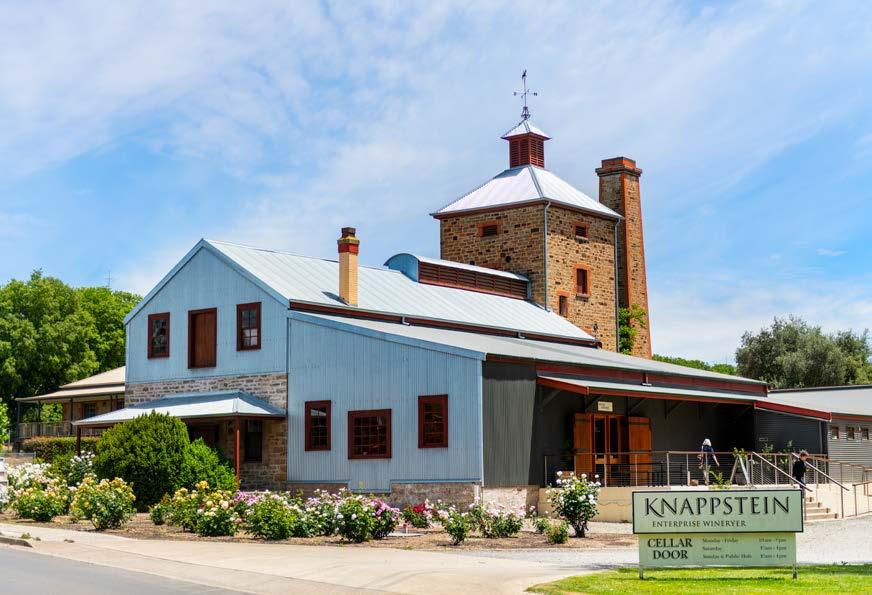
9 minute read
FEATURE Welcoming guests back to front of house following pandemic closures
Cellar Doors Sales
Re-opening the doors
Welcoming guests back to front of house following pandemic closures
Cellar doors took the brunt of COVID lockdowns, limiting their operations by limiting people from visiting. While many businesses made the most of what business they could muster, corks were popped once restrictions were lifted and visitor capacity was not so strict. Harrison Davies asked operators In Australia and New Zealand about how their cellar doors have rebounded since.
Knappstein cellar door
Many people throughout the wine industry never want to hear the words ‘COVID lockdown’ ever again. Businesses across the country were forced to contend with rules that prevented customers from entering their buildings for nearly two years, whether the rules were strict or lenient.
Cellar doors faced the brunt of these challenges more than any other part of the wine industry, as it was simply not permitted for consumers to walk through the doors for most of the pandemic. Businesses in Victoria, and particularly in regions adjacent to Melbourne, faced the longest lockdown in the world, over 260 straight days, where no visitations were allowed.
Other states, like South Australia and New South Wales, imposed more lenient restrictions on cellar doors, allowing a limited number of people to enter any particular venue. With different rules everywhere, the state of cellar doors was left somewhat in shambles.
Now, with pandemic restrictions in the rear-view mirror, cellar doors are finally experiencing a change in the wind. While the pre-pandemic status quo might be finding its way back to our shores, the lessons learned from the past two-plus years are still fresh.
New rules and new visitors
Rules were different for everyone across the industry based on what state they were based in.
During the pandemic, several states closed their borders and became open to just local, intrastate visitors. One such winery was Knappstein in the Clare Valley in South Australia. The state’s wine regions were open only to South Australians until the end of 2021, and throughout the pandemic had capacity limits in hospitality venues, usually around one person per 2m². This was a particular challenge for Knappstein, who had just completed a shiny new renovation of their Clare cellar door.
Knappstein cellar door manager Tania Matz said it was frustrating to have such a pleasant, large space that couldn’t be used to its full potential. “We’ve increased the footprint for our tasting area. So we’ve gone from being able to host, pre COVID, maybe 10 in our

Knappstein cellar door manager Tania Matz
tiny little cellar door, to now, without the restrictions, we can accommodate 60-80 people downstairs in different formats,” she said.
In Western Australia, Margaret River had to contend with similar challenges, with the state stringently locking out the rest of the country well into 2022. WA operators did not, however, have to work around any additional restrictions and they saw a boom in local visitations. Margaret River Wine Association CEO Amanda Whiteland said some producers have since experienced their busiest months ever after the border re-opened early in 2022. “The mix has been changing,” she said. “So obviously with the closed border, it was very much a West Australian market.
“We’ve seen the interstate and international visitors coming back, which has been great, but I think it’s still building up. “I did have a producer tell me they’re having their busiest month ever this month.”
WA wine tourism is now being powered by out-of-state and, particularly, overseas visitors.
Their strong visitation is being bolstered by a still-strengthened intrastate visitation rate.

Knappstein cellar door manager Tania Matz
Broadcast on Daily Wine News, social media and more!
Adding to your STAFF?

Visit

LIST WITH US ONLINE
Monthly staff
favourite from the Top Dogs Competition 2022 DYLAN General overseer
Known as a total goofball out of hours, Dylan is 100 per cent focused while on the job. He enjoys practicing his reception skills by occasionally barking at nothing. Has excellent timekeeping, ensuring everyone takes their breaks by relentlessly demanding a game of fetch at 10.30, 12.00 and 3.00 on the dot. Dylan will help move winery hoses with the same level of vigour and enthusiasm that he shows for the vacuum cleaner at home.
He will gladly receive butt rubs to promote overall workplace well-being and is such a good boy.
TOP DOG

Tania Matz
“We’ve just had a lot of international and interstates coming back and we’ve had really strong support from the domestic market,” she continued.
“I think [WA visitors] are still coming. I don’t think its increasing though. We’ve just had the international interest rate added on top.” Meanwhile in Victoria, visitors have only just begun filtering back through the doors once again. Even after the tight restrictions that prevented visitors from coming at all were lifted, lesser restrictions still prevented cellar doors from operating at full capacity for several months, although these too were gradually removed. Zonzo Estate in the Yarra Valley made wine production a much bigger part of its business as a result of the pandemic, but the role its cellar door has now changed again since visitors started to return. Director Rod Micallef said his team was excited to get customers in once again, albeit the move from strict rules to none had been a bit jarring. “In Victoria, we had staggered opening and we had restrictions. So we chose not to open the cellar door at first,” he said. “In our cellar door building, we were only allowed, say, 20 odd people and it was better business to book restaurant seatings, because they are our guaranteed income, instead of just staying in waiting for someone to come in and do a tasting and perhaps buy wine; so we thought we’d take the sales on set menus before.
“Once the cellar door opened, then we were allowed to do tastings and masks were not mandatory and all that stuff. He said they had found the situation difficult as staff had only been able to remove their masks in the last couple of months.
Old dogs and new tricks
Lessons were leaned from the years living with COVID-19 restrictions, as cellar doors were forced to change the ways they offered their services. Zonzo was forced to change its model completely, but the changes made during that period have now led to a longerlasting new approach for running the cellar door.
Due to the staggered opening hours, Zonzo began adapting its tastings to a virtual reality (VR) format, where all bottles have QR codes that link to a video walking consumers through the tasting. This technology has been brought into the cellar door and Micallef said its use has been a success.
“This is something that we’ve dreamt of many, many years ago; we were talking about doing virtual reality wine,” he said.
The Zonzo cellar door in the Yarra Valley

“COVID sort of worked in a way for QR codes because everyone was used to using them and so it became second nature for people to scan one of those. “We have created a series of online videos that cover all our tastings. “There is now a QR code on the back of all our bottles so [customers] can choose to buy tasting and they get their flight of glasses, and then they can choose to do that at a table and watch the tasting on a video from the phone. “So you choose your wines, we give you [your wines], you watch the tasting on your phone, then you can choose to buy online there and then, you can have it delivered home or to your table.” Elsewhere, many cellar doors had begun to experiment with seated tastings prior to COVID. Seated tastings entered their moment in vogue during COVID, as they were one way
Rod Micallef

The Zonzo cellar door in the Yarra Valley

that allowed visitors to sample wineries’ ranges. Knappstein had been experimenting with seated tastings prior to the restrictions, but have now made them a priority. “We’ve continued to offer the seated tastings, because we’ve found that our staff are engaging more with the guests that we have in cellar door when they are seated,” said Matz. “It’s also generated more sales; one thing we’ve noticed with our seated tastings is that people have gone to more of our premium selection rather than our regional selection. “We’ve noticed more sales; the sales of our premium wines have increased just because of the way we’re delivering the tastings.”
Many hands and still plenty of work
While cellar doors are again seeing a good reception from visitors, the challenge of securing the required labour still hangs like a cloud over the successes that many are experiencing. The labour shortage has hit the hospitality industry particularly hard, and cellar door managers have said the situation is particularly challenging. “We’ve got labour shortages in [Margaret River], as do probably the whole country, and we’re not running at full capacity,” Whiteland said.
“Within the capacity of the labour shortages, it’s school holidays here at the moment, and it’s definitely busy.” Micallef mirrored Whiteland’s comments.
“What we found now is, even though we get people on board, their skill and level of knowledge is not where we want it to be,” he said. “That’s where the digital form of that cellar door tasting has really come into play where we’re not depending on staff that just started to try and sell products or deal correct tastings “It used to be that you interview people and choose the best candidate. Now it’s like [if] someone applied, give them a job over email.”
While the first stages of the recovery may have been swift, the lingering effects of pandemic restrictions may remain a factor for cellar door operators for some time to come.
Amanda Whiteland










